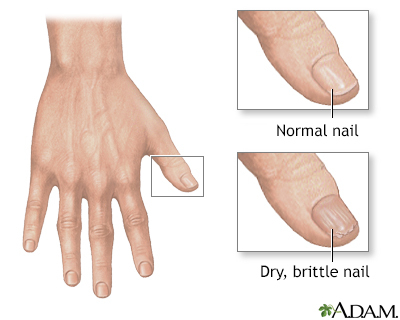Nail abnormalities
Definition
Nail abnormalities are problems with the color, shape, texture, or thickness of the fingernails or toenails.
Alternative Names
Beau lines; Fingernail abnormalities; Spoon nails; Onycholysis; Leukonychia; Koilonychia; Brittle nails
Considerations
Like the skin, the fingernails tell a lot about your health:
- Beau lines are depressions across the fingernail. These lines can occur after illness, injury to the nail, eczema around the nail, during chemotherapy for cancer, or when you do not get enough nutrition.
- Brittle nails are often a normal result of aging. They can also be due to certain diseases and conditions.
- Koilonychia is an abnormal shape of the fingernail. The nail has raised ridges and is thin and curved inward. This disorder is associated with iron deficiency anemia.
- Leukonychia is white streaks or spots on the nails often due to drugs or disease.
- Pitting is the presence of small depressions on the nail surface. Sometimes the nail is also crumbling. The nail can become loose and sometimes falls off. Pitting is associated with psoriasis and alopecia areata.
- Ridges are tiny, raised lines that develop across or up and down the nail.
Causes
Injury:
- Crushing the base of the nail or the nail bed may cause a permanent deformity.
- Chronic picking or rubbing of the skin behind the nail can cause median nail dystrophy, which gives a lengthwise split or ridged appearance of the thumbnails.
- Long-term exposure to moisture or nail polish can cause nails to peel and become brittle.
Infection:
- Fungus or yeast cause changes in the color, texture, and shape of the nails.
- Bacterial infection may cause a change in nail color or painful areas of infection under the nail or in the surrounding skin. Severe infections may cause nail loss. Paronychia is an infection around the nailfold and cuticle.
- Viral warts may cause a change in the shape of the nail or ingrown skin under the nail.
- Certain infections (especially of the heart valve) may cause red streaks in the nail bed (splinter hemorrhages).
Diseases:
- Disorders that affect the amount of oxygen in the blood (such as heart problems and lung diseases including cancer or infection) may cause clubbing.
- Kidney disease can cause a build-up of nitrogen waste products in the blood, which can damage nails.
- Liver disease can damage nails.
- Thyroid diseases such as hyperthyroidism or hypothyroidism may cause brittle nails or splitting of the nail bed from the nail plate (onycholysis).
- Severe illness or surgery may cause horizontal depressions in the nails Beau lines.
- Psoriasis may cause pitting, splitting of the nail plate from the nail bed, and chronic (long-term) destruction of the nail plate (nail dystrophy).
- Other conditions that can affect the appearance of the nails include systemic amyloidosis, malnutrition, vitamin deficiency, and lichen planus.
- Skin cancers near the nail and fingertip can distort the nail. Subungual melanoma is a potentially deadly cancer that will normally appear as a dark streak down the length of the nail.
- Hutchinson sign is a darkening of the cuticle associated with a pigmented streak and may be a sign of an aggressive melanoma.
Poisons:
- Arsenic poisoning may cause white lines and horizontal ridges.
- Silver intake can cause a blue nail.
Medicines:
- Certain antibiotics can cause lifting of the nail from the nail bed.
- Chemotherapy medicines can affect nail growth.
Normal aging affects the growth and development of the nails.
Home Care
To prevent nail problems:
- DO NOT bite, pick, or tear at your nails (in severe cases, some people may need counseling or encouragement to stop these behaviors).
- Keep hangnails clipped.
- Wear shoes that do not squeeze the toes together, and always cut toenails straight across along the top.
- To prevent brittle nails, keep the nails short and do not use nail polish. Use an emollient (skin softening) cream after washing or bathing.
Bring your own manicure tools to nail salons and DO NOT allow the manicurist to work on your cuticles.
Using the vitamin biotin in high doses (5,000 micrograms daily) and clear nail polish that contains protein can help strengthen your nails. Ask your provider about medicines that help with abnormal-appearing nails. If you have a nail infection, you may be prescribed antifungal or antibacterial drugs.
When to Contact a Medical Professional
Call your health care provider if you have:
- Blue nails
- Clubbed nails
- Distorted nails
- Horizontal ridges
- Pale nails
- White lines
- White color under the nails
- Pits in your nails
- Peeling nails
- Painful nails
- Ingrown nails
If you have splinter hemorrhages or Hutchinson sign, see the provider immediately.
What to Expect at Your Office Visit
The provider will look at your nails and ask about your symptoms. Questions may include whether you injured your nail, if your nails are constantly exposed to moisture, or whether you are always picking at your nails.
Tests that may be ordered include x-rays, blood tests, or examination of parts of the nail or the nail matrix in the laboratory.
Gallery








References
American Academy of Dermatology website. 12 nail changes a dermatologist should examine. www.aad.org/public/everyday-care/nail-care-secrets/basics/nail-changes-dermatologist-should-examine. Accessed July 23, 2021.
Andre J, Sass U, Theunis A. Diseases of the nails. In: Calonje E, Brenn T, Lazar AJ, Billings SD, eds. McKee's Pathology of the Skin with Clinical Correlations. 5th ed. Philadelphia, PA: Elsevier; 2020:chap 23.
Tosti A. Diseases of hair and nails. In: Goldman L, Schafer AI, eds. Goldman-Cecil Medicine. 26th ed. Philadelphia, PA: Elsevier; 2020:chap 413.
